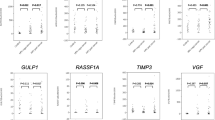Abstract
The etiology of oral carcinogenesis appears to be multifactorial. There is emerging evidence of the presence of Epstein–Barr virus (EBV) in epithelial oral squamous cell carcinoma (OSCC), but an association of EBV with oral carcinogenesis has not yet been established. Although epigenetic alterations, such as aberrant DNA methylation, are known to contribute to the pathogenesis of oral cancer, the relationship of such alterations with EBV infection is little known. This study aimed to investigate the association between EBV infection and promoter methylation patterns of tumor-associated genes in OSCC tissues. A total of 165 of formalin-fixed paraffin-embedded OSCC tissues were studied (68 of EBV positive and 97 of EBV negative). The promoter methylation patterns were investigated for four tumor-associated genes, E-cadherin, p16 INK4a, p14 ARF, and MGMT, by using methylation-specific polymerase chain reaction (MSP). The frequencies of gene promoter hypermethylation in all cases were 47.3% for E-cadherin, 92.7% for p16 INK4a, 74.5% for p14 ARF, and 35.8% for MGMT. Interestingly, most of the analyzed gene promoters were more frequently hypermethylated in EBV-positive than EBV-negative cases, in particular the E-cadherin (56/22) and MGMT (38/21) gene promoters (p < 0.05). Concomitantly, hypermethylation of multiple gene promoters (≥3) was encountered more frequently in EBV-positive samples. Hypermethylation of the E-cadherin promoter associated with EBV was more frequently observed in moderately and poorly differentiated OSCC tissues. These results indicate that epigenetic changes frequently occur in OSCCs and may partly be induced by EBV infection, therefore, EBV may involve in development and progression of the OSCCs.



Similar content being viewed by others
References
Ferlay J, Soerjomataram I, Dikshit R, Eser S, Mathers C, Rebelo M, et al. Cancer incidence and mortality worldwide: sources, methods and major patterns in GLOBOCAN 2012. Int J Cancer. 2015;136(5):E359–86. doi:10.1002/ijc.29210.
Parkin DM, Stjernsward J, Muir CS. Estimates of the worldwide frequency of twelve major cancers. Bull World Health Organ. 1984;62(2):163–82.
Scully C, Bagan J. Oral squamous cell carcinoma: overview of current understanding of aetiopathogenesis and clinical implications. Oral Dis. 2009;15(6):388–99. doi:10.1111/j.1601-0825.2009.01563.x.
Scully C, Bagan J. Oral squamous cell carcinoma overview. Oral Oncol. 2009;45(4–5):301–8. doi:10.1016/j.oraloncology.2009.01.004.
Bagan JV, Scully C. Recent advances in Oral Oncology 2008; squamous cell carcinoma aetiopathogenesis and experimental studies. Oral Oncol. 2009;45(7):e45–8. doi:10.1016/j.oraloncology.2008.12.012.
Sand L, Wallstrom M, Hirsch JM. Smokeless tobacco, viruses and oral cancer. Oral Health Dental Manag. 2014;13(2):372–8.
Miller CS, Johnstone BM. Human papillomavirus as a risk factor for oral squamous cell carcinoma: a meta-analysis, 1982–1997. Oral Surg Oral Med Oral Pathol Oral Radiol Endod. 2001;91(6):622–35. doi:10.1067/moe.2001.115392.
Ringstrom E, Peters E, Hasegawa M, Posner M, Liu M, Kelsey KT. Human papillomavirus type 16 and squamous cell carcinoma of the head and neck. Clin Cancer Res. 2002;8(10):3187–92.
Kreimer AR, Clifford GM, Boyle P, Franceschi S. Human papillomavirus types in head and neck squamous cell carcinomas worldwide: a systematic review. Cancer Epidemiol Biomarkers Prev. 2005;14(2):467–75. doi:10.1158/1055-9965.EPI-04-0551.
Fakhry C, Gillison ML. Clinical implications of human papillomavirus in head and neck cancers. J Clin Oncol. 2006;24(17):2606–11. doi:10.1200/JCO.2006.06.1291.
Syrjanen S. Viral infections in oral mucosa. Scand J Dent Res. 1992;100(1):17–31.
Sand L, Jalouli J. Viruses and oral cancer. Is there a link? Microbes Infect/Institut Pasteur. 2014;16(5):371–8. doi:10.1016/j.micinf.2014.02.009.
Jalouli J, Ibrahim SO, Sapkota D, Jalouli MM, Vasstrand EN, Hirsch JM, et al. Presence of human papilloma virus, herpes simplex virus and Epstein–Barr virus DNA in oral biopsies from Sudanese patients with regard to toombak use. J Oral Pathol Med. 2010;39(8):599–604. doi:10.1111/j.1600-0714.2010.00910.x.
Jalouli J, Ibrahim SO, Mehrotra R, Jalouli MM, Sapkota D, Larsson PA, et al. Prevalence of viral (HPV, EBV, HSV) infections in oral submucous fibrosis and oral cancer from India. Acta Otolaryngol. 2010;130(11):1306–11. doi:10.3109/00016481003782041.
Acharya S, Ekalaksananan T, Vatanasapt P, Loyha K, Phusingha P, Promthet S, et al. Association of Epstein–Barr virus infection with oral squamous cell carcinoma in a case-control study. J Oral Pathol Med. 2015;44(4):252–7. doi:10.1111/jop.12231.
de Groot JS, Pan X, Meeldijk J, van der Wall E, van Diest PJ, Moelans CB. Validation of DNA promoter hypermethylation biomarkers in breast cancer—a short report. Cell Oncol. 2014;37(4):297–303. doi:10.1007/s13402-014-0189-1.
Yiannakopoulou E. Targeting epigenetic mechanisms and microRNAs by aspirin and other non steroidal anti-inflammatory agents—implications for cancer treatment and chemoprevention. Cell Oncol. 2014;37(3):167–78. doi:10.1007/s13402-014-0175-7.
Singal R, Ginder GD. DNA methylation. Blood. 1999;93(12):4059–70.
Baylin SB. Tying it all together: epigenetics, genetics, cell cycle, and cancer. Science. 1997;277(5334):1948–9.
Baylin SB, Herman JG. DNA hypermethylation in tumorigenesis: epigenetics joins genetics. Trends Genet. 2000;16(4):168–74.
Herman JG, Baylin SB. Gene silencing in cancer in association with promoter hypermethylation. N Engl J Med. 2003;349(21):2042–54. doi:10.1056/NEJMra023075.
Esteller M. Relevance of DNA methylation in the management of cancer. Lancet Oncol. 2003;4(6):351–8.
Yousuf A, Bhat MY, Pandith AA, Afroze D, Khan NP, Alam K, et al. MGMT gene silencing by promoter hypermethylation in gastric cancer in a high incidence area. Cell Oncol. 2014;37(4):245–52. doi:10.1007/s13402-014-0179-3.
Duijkers FA, de Menezes RX, Goossens-Beumer IJ, Stumpel DJ, Admiraal P, Pieters R, et al. Epigenetic drug combination induces genome-wide demethylation and altered gene expression in neuro-ectodermal tumor-derived cell lines. Cell Oncol. 2013;36(5):351–62. doi:10.1007/s13402-013-0140-x.
D’Souza W, Saranath D. Clinical implications of epigenetic regulation in oral cancer. Oral Oncol. 2015;51(12):1061–8. doi:10.1016/j.oraloncology.2015.09.006.
Arantes LM, de Carvalho AC, Melendez ME, Carvalho AL, Goloni-Bertollo EM. Methylation as a biomarker for head and neck cancer. Oral Oncol. 2014;50(6):587–92. doi:10.1016/j.oraloncology.2014.02.015.
Tsai CN, Tsai CL, Tse KP, Chang HY, Chang YS. The Epstein–Barr virus oncogene product, latent membrane protein 1, induces the downregulation of E-cadherin gene expression via activation of DNA methyltransferases. Proc Natl Acad Sci USA. 2002;99(15):10084–9. doi:10.1073/pnas.152059399.
Leal M, Lima E, Silva P, Assumpcao P, Calcagno D, Payao S, et al. Promoter hypermethylation of CDH1, FHIT, MTAP and PLAGL1 in gastric adenocarcinoma in individuals from Northern Brazil. World J Gastroenterol. 2007;13(18):2568–74.
Supic G, Kozomara R, Brankovic-Magic M, Jovic N, Magic Z. Gene hypermethylation in tumor tissue of advanced oral squamous cell carcinoma patients. Oral Oncol. 2009;45(12):1051–7. doi:10.1016/j.oraloncology.2009.07.007.
Wong TS, Tang KC, Kwong DL, Sham JS, Wei WI, Kwong YL, et al. Differential gene methylation in undifferentiated nasopharyngeal carcinoma. Int J Oncol. 2003;22(4):869–74.
Zheng Z, Pan J, Chu B, Wong YC, Cheung AL, Tsao SW. Downregulation and abnormal expression of E-cadherin and beta-catenin in nasopharyngeal carcinoma: close association with advanced disease stage and lymph node metastasis. Hum Pathol. 1999;30(4):458–66.
Krishna SM, Kattoor J, Balaram P. Down regulation of adhesion protein E-cadherin in Epstein–Barr virus infected nasopharyngeal carcinomas. Cancer Biomark. 2005;1(6):271–7.
Kwong J, Lo KW, To KF, Teo PM, Johnson PJ, Huang DP. Promoter hypermethylation of multiple genes in nasopharyngeal carcinoma. Clin Cancer Res. 2002;8(1):131–7.
Sanchez-Cespedes M, Esteller M, Wu L, Nawroz-Danish H, Yoo GH, Koch WM, et al. Gene promoter hypermethylation in tumors and serum of head and neck cancer patients. Can Res. 2000;60(4):892–5.
Dhiab MB, Ziadi S, Mestiri S, Gacem RB, Ksiaa F, Trimeche M. DNA methylation patterns in EBV-positive and EBV-negative Hodgkin lymphomas. Cell Oncol. 2015;38(6):453–62. doi:10.1007/s13402-015-0242-8.
Serrano M, Hannon GJ, Beach D. A new regulatory motif in cell-cycle control causing specific inhibition of cyclin D/CDK4. Nature. 1993;366(6456):704–7. doi:10.1038/366704a0.
Herman JG, Merlo A, Mao L, Lapidus RG, Issa JP, Davidson NE, et al. Inactivation of the CDKN2/p16/MTS1 gene is frequently associated with aberrant DNA methylation in all common human cancers. Can Res. 1995;55(20):4525–30.
Merlo A, Herman JG, Mao L, Lee DJ, Gabrielson E, Burger PC, et al. 5′ CpG island methylation is associated with transcriptional silencing of the tumour suppressor p16/CDKN2/MTS1 in human cancers. Nat Med. 1995;1(7):686–92.
Al-Kaabi A, van Bockel LW, Pothen AJ, Willems SM. p16INK4A and p14ARF gene promoter hypermethylation as prognostic biomarker in oral and oropharyngeal squamous cell carcinoma: a review. Dis Markers. 2014;2014:260549. doi:10.1155/2014/260549.
De Schutter H, Geeraerts H, Verbeken E, Nuyts S. Promoter methylation of TIMP3 and CDH1 predicts better outcome in head and neck squamous cell carcinoma treated by radiotherapy only. Oncol Rep. 2009;21(2):507–13.
Ohta S, Uemura H, Matsui Y, Ishiguro H, Fujinami K, Kondo K, et al. Alterations of p16 and p14ARF genes and their 9p21 locus in oral squamous cell carcinoma. Oral Surg Oral Med Oral Pathol Oral Radiol Endod. 2009;107(1):81–91. doi:10.1016/j.tripleo.2008.08.027.
Lim KP, Sharifah H, Lau SH, Teo SH, Cheong SC. Alterations of the p14ARF-p53-MDM2 pathway in oral squamous cell carcinoma: MDM2 overexpression is a common event. Oncol Rep. 2005;14(4):963–8.
Smeds J, Berggren P, Ma X, Xu Z, Hemminki K, Kumar R. Genetic status of cell cycle regulators in squamous cell carcinoma of the oesophagus: the CDKN2A (p16(INK4a) and p14(ARF)) and p53 genes are major targets for inactivation. Carcinogenesis. 2002;23(4):645–55.
Ishida E, Nakamura M, Ikuta M, Shimada K, Matsuyoshi S, Kirita T, et al. Promotor hypermethylation of p14ARF is a key alteration for progression of oral squamous cell carcinoma. Oral Oncol. 2005;41(6):614–22. doi:10.1016/j.oraloncology.2005.02.003.
Ruesga MT, Acha-Sagredo A, Rodriguez MJ, Aguirregaviria JI, Videgain J, Rodriguez C, et al. p16(INK4a) promoter hypermethylation in oral scrapings of oral squamous cell carcinoma risk patients. Cancer Lett. 2007;250(1):140–5. doi:10.1016/j.canlet.2006.10.001.
Xing XB, Cai WB, Luo L, Liu LS, Shi HJ, Chen MH. The prognostic value of p16 hypermethylation in cancer: a meta-analysis. PLoS ONE. 2013;8(6):e66587. doi:10.1371/journal.pone.0066587.
Acknowledgements
This work was supported by the Thailand Research Fund and Khon Kaen University through the Royal Golden Jubilee Ph.D. Program (Grant No. PHD/0041/2557) and by Khon Kaen University (Grant No. 581201 and 592001). We would like to acknowledge Prof. David Blair for English editing the MS via Publication Clinic KKU.
Author information
Authors and Affiliations
Corresponding author
Ethics declarations
Conflict of interest
The authors declare no conflict of interest.
Ethical approval
Ethical approval was given by the Khon Kaen University Ethics Committee (No. HE 581211). All procedures performed in studies involving human participants were in accordance with the ethical standards of the institutional and/or national research committee and with the 1964 Helsinki Declaration and its later amendments or comparable ethical standards.
Informed consent
Informed consent was obtained from all individual participants included in the study, giving their authorization to access their clinical information and tumor samples for research purpose.
Electronic supplementary material
Below is the link to the electronic supplementary material.
Rights and permissions
About this article
Cite this article
Burassakarn, A., Pientong, C., Sunthamala, N. et al. Aberrant gene promoter methylation of E-cadherin, p16 INK4a, p14 ARF, and MGMT in Epstein–Barr virus-associated oral squamous cell carcinomas. Med Oncol 34, 128 (2017). https://doi.org/10.1007/s12032-017-0983-5
Received:
Accepted:
Published:
DOI: https://doi.org/10.1007/s12032-017-0983-5




